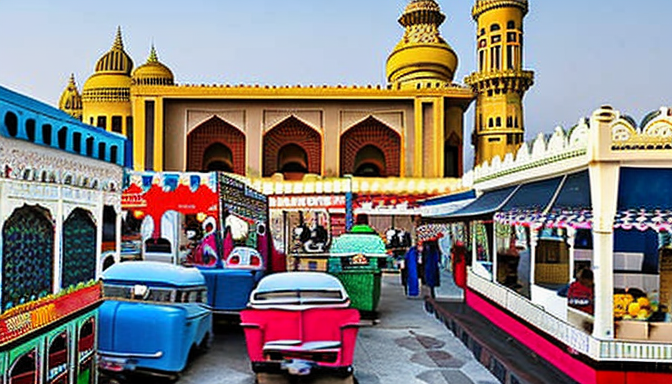Karachi is not just a city; it’s a canvas painted with the colors of various cultures. Walking through its streets, you can feel the pulse of history in every building. From the majestic Frere Hall, with its Gothic revival style, to the intricate designs of the Mohatta Palace, each structure tells a story. These historic buildings are like pages in a book, revealing the rich tapestry of Karachi’s past.
The city’s architectural landscape is dotted with stunning mosques that reflect the Islamic heritage. The Grand Mosque and the Masjid-e-Tooba stand out, showcasing beautiful domes and intricate tile work. They are not just places of worship; they are symbols of the city’s spirituality and artistic expression. Karachi’s monuments, like the Mazar-e-Quaid, serve as reminders of the nation’s journey and its leaders.
Each of these structures is a testament to the cultural exchanges that have shaped Karachi over the years. The blend of British colonial architecture and local craftsmanship creates a unique style that is distinctly Karachi. As you stroll through the city, you might notice how modern buildings are seamlessly integrating with these historic elements. It’s a beautiful dance of old and new, where every corner holds a surprise.
Historical Influences on Karachi’s Architecture
Karachi’s architectural story is a fascinating tapestry woven from threads of history and culture. As you stroll through the city, you’re not just walking on streets; you’re walking through time. The city’s architecture reflects a myriad of influences, from the ancient to the contemporary. Each building tells a tale, revealing how Karachi evolved into a vibrant metropolis.
Take a moment to admire the stunning Frere Hall, a Victorian Gothic structure that stands as a reminder of British colonial rule. Its intricate arches and lush gardens are a nod to the past, inviting you to ponder the stories hidden within its walls. Similarly, the Mohatta Palace, with its pink sandstone and Islamic motifs, showcases the fusion of local and foreign styles, creating a visual feast for the eyes.
Don’t forget the magnificent mosques that dot the landscape. The Grand Mosque and the Masjid-e-Tooba are not just places of worship; they are architectural marvels. Their designs reflect a blend of traditional Islamic art and modern engineering, standing tall as symbols of faith and community. Each mosque tells a story of devotion and craftsmanship, serving as a bridge between history and modernity.
In essence, Karachi’s architecture is a melting pot of influences. From colonial buildings to religious monuments, each structure adds a unique flavor to the city’s identity. It’s a reminder that architecture is not just about bricks and mortar; it’s about the people and stories that shape our world.

Modern Architectural Trends in Karachi
Karachi is a city that never sleeps. Its skyline is a canvas where modernity meets tradition. As you stroll through its bustling streets, you’ll notice a fascinating mix of architectural styles. The old and the new dance together, creating a unique urban landscape. Have you ever seen a contemporary skyscraper standing proudly next to a historic mosque? It’s like watching a time traveler walk side by side with a wise sage.
Take, for instance, the stunning modern buildings that dot the city. They are not just structures; they are statements. Architects are now blending glass facades with traditional elements, creating a dialogue between the past and the present. This fusion is evident in places like the Dolmen Mall and Karachi’s City Court, where sleek lines meet intricate local designs.
But what’s driving this architectural evolution? Here are some key factors:
- Urbanization: The city’s rapid growth demands innovative spaces.
- Cultural Exchange: Influences from global architecture are reshaping local designs.
- Sustainability: There’s a growing emphasis on eco-friendly materials and practices.
These trends are not just about aesthetics; they reflect the cultural identity of Karachi. Each building tells a story, capturing the essence of a city that is constantly evolving. As Karachi embraces its future, it’s crucial to remember its roots. The blend of cultures, histories, and modern aspirations shapes a vibrant architectural identity that is truly one of a kind.
Frequently Asked Questions
- What influences have shaped Karachi’s architectural identity?
Karachi’s architectural identity is a vibrant tapestry woven from various cultural influences, including British colonial, Mughal, and modernist styles. Each period has left its mark, creating a unique blend that reflects the city’s rich history and diverse population.
- How does modern architecture in Karachi integrate traditional elements?
Modern architecture in Karachi often incorporates traditional motifs and materials, creating a dialogue between the past and the present. Architects are increasingly blending sleek, contemporary designs with local craftsmanship and cultural symbols, resulting in structures that resonate with the city’s heritage.
- Why is Karachi’s architecture considered a cultural melting pot?
Karachi’s architecture is a cultural melting pot because it showcases a variety of styles and influences from different eras and communities. This eclectic mix not only represents the city’s history but also its ongoing evolution as a hub of cultural exchange.